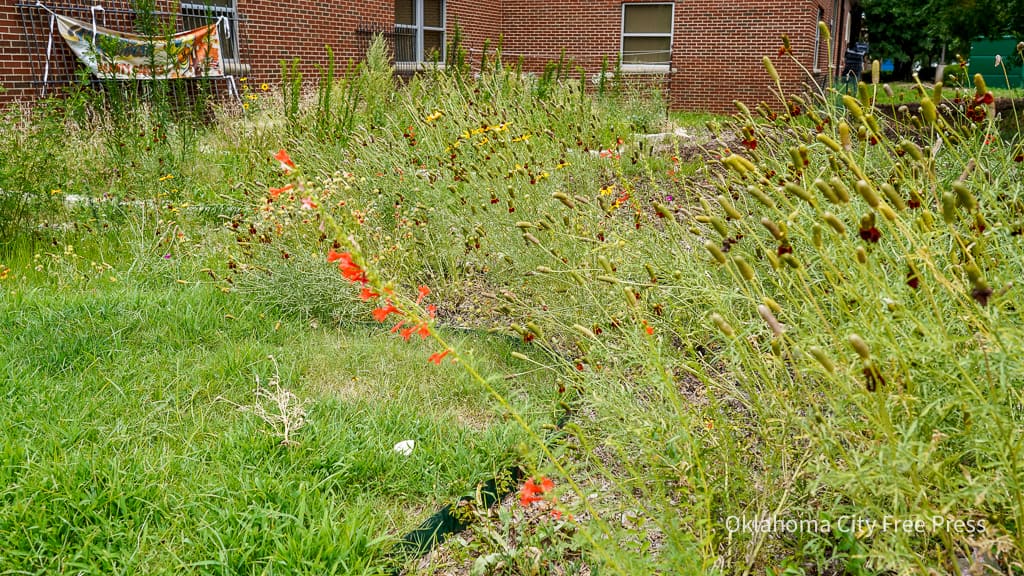Last Updated on August 6, 2023, 2:50 AM | Published: May 14, 2023
OKLAHOMA CITY — There’s no shortage of summer traditions to look forward to, days at the pool, cookouts, and campfires. But for many OKC residents, the longer days of sunshine bring a rapid growth of grass and weeds that can be difficult to keep up with.
If grass and weeds reach a certain length or cause inconveniences, residents may be at risk of receiving a notice, often triggered when their neighbors call the city government and complain.
Understandably, some residents are fully in favor of the system in place, others feel targeted by it.
Number one complaint
The number one complaint in the city is of high grass and weeds – more than graffiti, abandoned vehicles, or even potholes, and summer is the busiest time of year for complaints.
The Oklahoma City Action Center aids in the reports of non-emergency code violations like high grass and weeds. Residents can contact this office through text, email, phone call, or Twitter to report an issue, and it is directed to the appropriate departments for investigation or inspection.

The High Grass and Weeds Ordinance (Municipal Code Chapter 35, Section 63) came into effect on March 19, 1974.
The city ordinance defines grass to be in violation when it reaches 12 inches of height or otherwise impedes public safety. Property owners are also responsible for maintaining any alleys or right-of-ways adjacent to their property.
A property owner could be issued a notice for either their front or back yard, but the majority of the yard (60%) must be in violation. In other words, an outbreak of weeds or tall grass in a flower bed wouldn’t constitute a violation. If there is a violation in a back or side yard, it must be viewable from the street, and inspectors cannot look over fences.
Notice of violation
When the Oklahoma City Action Center receives a complaint, it’s sent to Code Enforcement, who are essentially tasked with enforcing the city ordinance. An inspector from the Code Enforcement office will inspect the yard and take pictures.
If they find they are in violation, the property owner will receive a violation notice, which is a small flag in the yard. A notice will also be mailed to the property owner. At that point, they have about two weeks to resolve the issue before the inspector returns.
In extenuating circumstances like sickness or financial burden, the Code Enforcement office may give an additional two weeks to resolve the violation. The lawn is usually mowed within days, according to Oklahoma City Action Center Manager Shameka Lee.
If a property owner has not requested an extension and is still in violation, the city will send a contractor to cut the yard at the homeowner’s expense. If not paid, a lien could be placed on the property.
A yard divided
According to Lee, public opinion about the ordinance is generally positive, especially since so many complaints are filed.
“People love having the option of calling the city because we do actually enforce it,” Lee said. “We do the leg work. Rather than just trying to figure out who does the lawn, we do it.”
According to Oklahoma City resident Jordan Norris, the issue is more complicated. “Prevalence does not equate to seriousness,” Norris said.
Norris has received two tall grass and weeds violations, the most recent of which was in 2021 when living in Oklahoma City. During each instance, she was renting the property.
For renters especially, things can get muddled.
Prevalence does not equate to seriousness
— Jordan Norris, OKC
In the summer of 2021, when the heat reached record-breaking temperatures, Norris was unable to mow her lawn due to risks of heat exhaustion and eventually received a violation notice. It was in her contract that she would be responsible for cutting the lawn, but there was a lack of clarification on the frequency that was needed or the potential consequences for failing to cut the lawn.
There is an additional step for renters not just for researching city ordinances, but for clarifying contracts and responsibilities set by the landlord. What followed the violation notice was a lot of coordination of schedules between Norris, her landlord, and the lawn service.
“It was a whole headache and a half,” Norris said. “It was about three and a half days of anxiety that I didn’t need at the time.”
In some instances, lawn care information may even be left out or incomplete in a contract.
Sometimes, residents move to a new city or state where the rules are different, and they may not be looking up tall grass and weeds ordinances.

In other instances, Homeowners Association (HOA) rules may differ from that of the city, making the process confusing for some homeowners.
For residents like Norris, the issue goes deeper than a lack of clarity or the seemingly simple act of mowing or not mowing lawns. According to Norris, this issue more often affects people of lower economic status, often living closer to Oklahoma City than nearby suburbs.
“The best merit of a society is how you treat your most disadvantaged populous, and I do feel like this could be used as a potential punishment for people who simply cannot help it,” Norris said.
From Norris’s point of view, a punitive system encourages a culture of uniformity, especially in areas of the city that cannot afford the maintenance that goes into grass lawns. With the pressure of uniformity, Norris said people may give into the ecological damages of having their lawns look a certain way.
Impacts on the Environment – public safety
Where lawn care may seem purely cosmetic to a community, in some instances, there can be serious ecological effects of different approaches to lawn care.
In recent years, there’s been a push for pollinator lawns, a stray from traditional grass lawns with flowering pollinator plants, weeds, grasses, and flowers.
The city only handles what are called “noxious weeds,” which are plants that are considered harmful to public health, agriculture, recreation, wildlife, or property such as thistles.
So pollinator weeds like the dandelion, wild violet, and milkweed aren’t as much of an issue. Some neighbors may not approve of the nearby pollinator lawn, but as long as the lawn is not in direct violation, it may not be something requiring the city’s involvement.
“We get calls about that because people are very serious about their lawns,” Lee said. “We understand that, but you may have a neighbor who is just adamant about a certain type of grass.”
Norris is one of many Oklahoma City residents opting for a permaculture lawn using clover and wildflowers. More than just opportunities for pollinators, permaculture lawns have other positive impacts like having deeper roots that break up the soil, helping with water retention, and preventing both floods and droughts. In addition to this, if people let native weeds grow, they won’t be using as many pesticides or herbicides that can run into lakes and oceans.

On the other hand, when overgrown weeds heat up in the summer, they can become a fire hazard.
Tall weeds and grasses can also create a home for rodents and other animals. According to Lee, rodent harborage is the most common reason for complaints.
“It’s unhealthy for the society,” Lee said. “We don’t want mice, rats, and skunks in the community, so we have to make sure we’re keeping people healthy.”
Norris has a different perspective on rodent harborage, stating their value in the local ecosystem like feeding birds and other local wildlife.
“There is a lot of use to having those animals around, but because they have been designated as vermin, people don’t want them,” Norris said. “The environment is interconnected. When you erase one part of something, there are hundreds of different effects.”
For every argument for enforcing tall grasses and weeds, there’s an argument against it (and vice versa), making the issue complicated. Where perfectly manicured lawns could create chemical run-off, add to the risk of floods and droughts, or limit ecological diversity, overgrown weeds may heighten the risk of fires or disease spread through rodents.
This issue is as tangled as the tall grasses and weeds it deals with, and people come out on all different sides of the issue. Whether they’re the ones making the complaint because of concerns for community safety, or they’re dealing with the anxiety of being hit with a violation notice, there’s something deeply personal about the presentation of one’s home and the amount of control the city either should or shouldn’t have over it.
Zoe Travers has spent her career covering local musicians, artists, politicians, and everyday folks. She is also Oklahoma City’s most enthusiastic connoisseur of cheese danishes.











